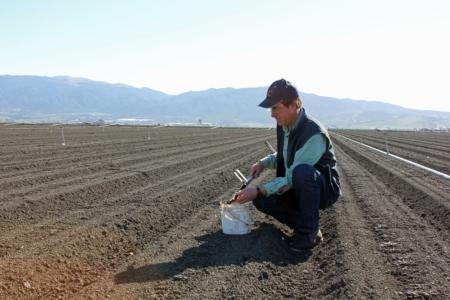Working to achieve healthy crops while limiting nitrate in water
UC Cooperative Extension and Agricultural Experiment Station researchers are working with growers on fertilizer management, irrigation efficiency and other farming practices to provide options for protecting groundwater, which serves as a primary drinking water source for many rural communities. The following are some examples of ANR research and extension projects under way. The scientists’ names are hyperlinked to their contact information.
Quick nitrate test guides fertilizer management
Michael Cahn and Richard Smith, UC Cooperative Extension advisors in Monterey County, and Tim Hartz, UCCE specialist in the department of Plant Sciences at UC Davis, have developed a quick test to measure soil nitrate in the field so growers can match fertilizer rates with plant needs. The test has reduced nitrogen-loading rates by an average of 70 pounds per acre in lettuce. On-farm demonstration trials have shown that by testing the soil, growers can reduce their fertilizer use by about 30 percent. Major growers in Monterey County, who manage a significant number of vegetable acres in the Salinas Valley, have begun using the quick nitrate test in their operations. For more information read the summary article on p. 5 and fine tuning article on p. 12 of Crop Notes.
Assessing plant nutrient status
Leaf sampling is a common method of determining when a nut tree has a nutrient deficiency. Patrick H. Brown, professor in the Department of Plant Sciences at UC Davis and Agricultural Experiment Station pomologist, and his colleagues are studying other ways of assessing plant nutrient status to help almond and pistachio growers manage fertilizer applications with more precision. For more information, see Crop Nutrient Status and Demand.
NBOT aids dairies in nutrient planning
The Nitrogen Budget Optimization Tool (NBOT) is a planning tool being developed for dairies by David Crohn, professor and UC Cooperative Extension specialist in the Department of Environmental Sciences at UC Riverside. NBOT is an algorithm that uses a daily time step to represent crop nitrogen demand, nitrogen mineralization and losses from leaching, denitrification and ammonia volatilization. Typical nitrogen application charts tell how much nitrogen a crop needs during the growing season, but they do not say when the crop will need it. With NBOT, dairy operators input information about the crop they are growing, how much they expect to harvest and when they can apply manures. NBOT’s output gives an idealized management strategy that helps dairy operators decide what they should do all year round.
N-Ledger software addresses nitrogen management
A software program under development by a team headed by Marsha Campbell Mathews, UC Cooperative Extension advisor in Stanislaus County, will help dairy operators and other farmers improve nitrogen management by calculating when nitrogen applied in manure is expected to be released from organic form into a form that the crops can use. Nitrogen applications are tracked, release rates are estimated and adjusted for expected losses, and the calculated total is compared to the expected daily crop need for nitrogen. The program helps the user choose an application strategy that will meet the crop’s needs and result in the least possible amount of nitrate in the soil during periods when it is vulnerable to leaching or other losses. For more information, see the UC Cooperative Extension in Stanislaus County Manure Nutrient Management website.
Adjusting field length can reduce irrigation levels
In his research on how dairy operators can reduce water applications to their crops, Larry Schwankl, UC Cooperative Extension specialist at Kearney Agricultural Research and Extension Center in Parlier, has found that allowing less water to percolate will reduce impacts on groundwater. With shorter furrows, water applied per acre was cut nearly in half. In addition, manure water is often added to fresh water as part of dairy irrigation and fertigation practices, so being able to reduce the applied water also significantly reduces the amount of nitrogen applied. For more information, see Schwankl's Irrigation Management website.
UC helps dairy industry manage nitrogen on the farm
It is common practice for dairy operators to use cattle manure as fertilizer for their silage crops. UC Cooperative Extension advisors throughout California routinely provide reliable information to dairy operators and consultants so they can efficiently manage nitrogen on the farm and comply with pending state regulations. This information includes how to install and calibrate flow meters, how to measure nitrogen levels in manure ponds, how much nitrogen crops need and when they need it, and how to properly sample the crops that are harvested to know how much nitrogen is being removed. “We’ve developed protocols to ensure accurate information gathering, and we can share these with the dairy industry,” said Carol Frate, UCCE advisor in Tulare County. For more information, contact a UC Cooperative Extension dairy advisor.
To see other ANR projects and publications aimed at limiting nitrate leaching, please visit http://ucanr.edu/News/Healthy_crops,_safe_water.

